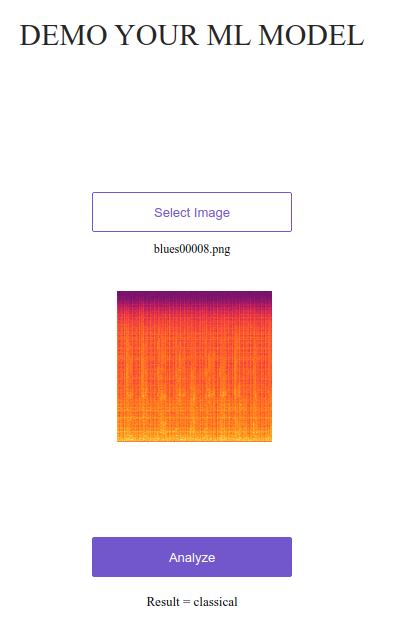
♫ - Music Genre Classification
Build a machine learning (ML) model that takes audio files as input and returns a corresponding music genre.
Building a model using fastai and deploying to GCP
Gist of everything
-
In approach lies all the steps taken
-
this cloud.google.article contains all the information about the deploying pytorch on GCP.
-
2 colab notebooks for creating data set and training model
-
repo for deploying the model on GCP for GCE
-
presentation given at Epidemic Sound 2019 music-genre-classfication
-
google app engine deployment repo is here https://github.com/eleijonmarck/music-genre-app-engine
Approach
Outcome of assignment
Expected outcome
- fastai library for model predictions
- serving the model in GCP w. their new custom prediction model function.
Actual outcome
- trained fastai library for model predictions
- serving the model in GCP w. Google App Engine
Outcome
Out of interest of time. The model is only trained on 2 classes ['classical', 'blues']
app - https://momentum-project.appspot.com/
upload - image from docs/img_data/*
Approach
Training the model
- Download data
- Find out research around the area of predicting music genre w. this particular data set.
- Found out about MelSpectrograms for predicting the whole songs seems to be the silver standard (not cutting edge).
- Using fastaiv3 for learning about the library of image classification and its approach to making a first model.
- Creating the data set for data augmentation / processing from raw audio file outputs to a Melspectrogram to represent the whole songs. (currently processed the blues, classical for interest of time) - colab: https://colab.research.google.com/drive/1CVMaHoJT_ECLADdRyyzqteVT-6oV-unb
- Train a image classifier using transfer learning w. ResNet as base - colab: https://colab.research.google.com/drive/1R4F85FIf0xdmEjeUm38WH4RhBgC_GGUf
- Deploying model to GCP.
-
Challenge here was that GCP does not natively support
pytorchmodels. March GCP released custom prediction capabilities and wanted to get my hands dirty Serving a PyTorch text classifier on AI Platform Serving using custom online prediction -
Challenge number 2 is that preprocessing can be dealt w. lambda functionality of the keras library. Hopefully we can make the preprocessing of the audio file into a image using the lambdas of keras. See preprocessing w. lambda keras
-
Challenge number 3 is use case. What is the actual use case of this? Depending on that :
Challenge number 2 might not even be relevant as we might only need this music-genre classification for post analytics. And therefore could postprocess data another way to skip the preprocessing directly from the api.
-
Exact steps made and challenges presented on the way
- Download data set from Download link
- Unzip the tar into your drive or an environment so you can pick it up from colab (as colab does not persist data)
- Creating the data set for training w. Melspectrograms. https://colab.research.google.com/drive/1CVMaHoJT_ECLADdRyyzqteVT-6oV-unb
- Training using the newly created
img_datausing fastai in colab https://colab.research.google.com/drive/1R4F85FIf0xdmEjeUm38WH4RhBgC_GGUf - deploy model using the newly created guide for deploying pytorch models for gcp
- current step/progress, when trying to deploy the custom model prediction
$ make create-model
OK
$ make create-version
gcloud alpha ai-platform versions create v2 --model music_genre_classification \
--origin=gs://music-genre-classification/music-genre-v1.0.0/ \
--python-version=3.5 \
--runtime-version=1.13 \
--package-uris=gs://music-genre-classification/python-prediction/music_genre_prediction-0.1.tar.gz \
--machine-type=mls1-c4-m4 \
--prediction-class=model.CustomModelPrediction
Creating version (this might take a few minutes)......failed.
ERROR: (gcloud.alpha.ai-platform.versions.create) Create Version failed. Bad model detected with error: "Failed to load model: User-provided package music_genre_prediction-0.1.tar.gz failed to install: Command '['python-default', '-m', 'pip', 'install', '--target=/tmp/custom_lib', '--no-cache-dir', '-b', '/tmp/pip_builds', '/tmp/custom_code/music_genre_prediction-0.1.tar.gz']' returned non-zero exit status 1 (Error code: 0)"
make: *** [Makefile:88: create-version] Error 1New Approach since the GCP AI Platform did not allow for deploying Pytorch models
-
Deploy on Google App Engine
-
Following the fastai guide on the fastai website.
- make a downloadable link of the model that you train
- deploy the app. Need to be EXACTLY the number of classes your are prediction w. the model. (This happened to be the cause of some unexplainable error)
-
Deployed app is up and running @ https://momentum-project.appspot.com/
-
Google App Engine does not allow requests to be built around cURL (c-language) requests. See curl-on-app-engine
-
Postman request instead https://www.getpostman.com/collections/c4a2cd9410835920354c
Would have taken some time to configura to setup cURL for GAE
$ curl --request POST \
> --url https://momentum-project.appspot.com/analyze \
> --header 'Accept: */*' \
> --header 'Accept-Encoding: gzip, deflate' \
> --header 'Connection: keep-alive' \
> --header 'Content-Length: 474050' \
> --header 'Content-Type: multipart/form-data; boundary=--------------------------890612561901535102156936' \
> --header 'Host: momentum-project.appspot.com' \
> --header 'User-Agent: PostmanRuntime/7.19.0' \
> --header 'content-type: multipart/form-data; boundary=----WebKitFormBoundary7MA4YWxkTrZu0gW' \
> --form file=@/home/eleijonmarck/dev/epidemic-sound-ml-assignment/data/img_data/classical/classical00011.png
curl: (92) HTTP/2 stream 0 was not closed cleanly: PROTOCOL_ERROR (err 1)📊 Data
As a dataset, use the (in)famous GTZAN Genre Collection dataset from
Tzanetakis, George, and Perry Cook. “Musical genre classification of audio signals.” IEEE Transactions on speech and audio processing 10.5 (2002): 293-302.
Download link and homepage for the dataset.
Next steps:
- create baseline
- make preprocessing step for images
- create embeddings of the melspectrogram features for visualizing in t-SNE
- signal processing for melspectrograms to create MFCC features - https://www.youtube.com/watch?v=Z7YM-HAz-IY
